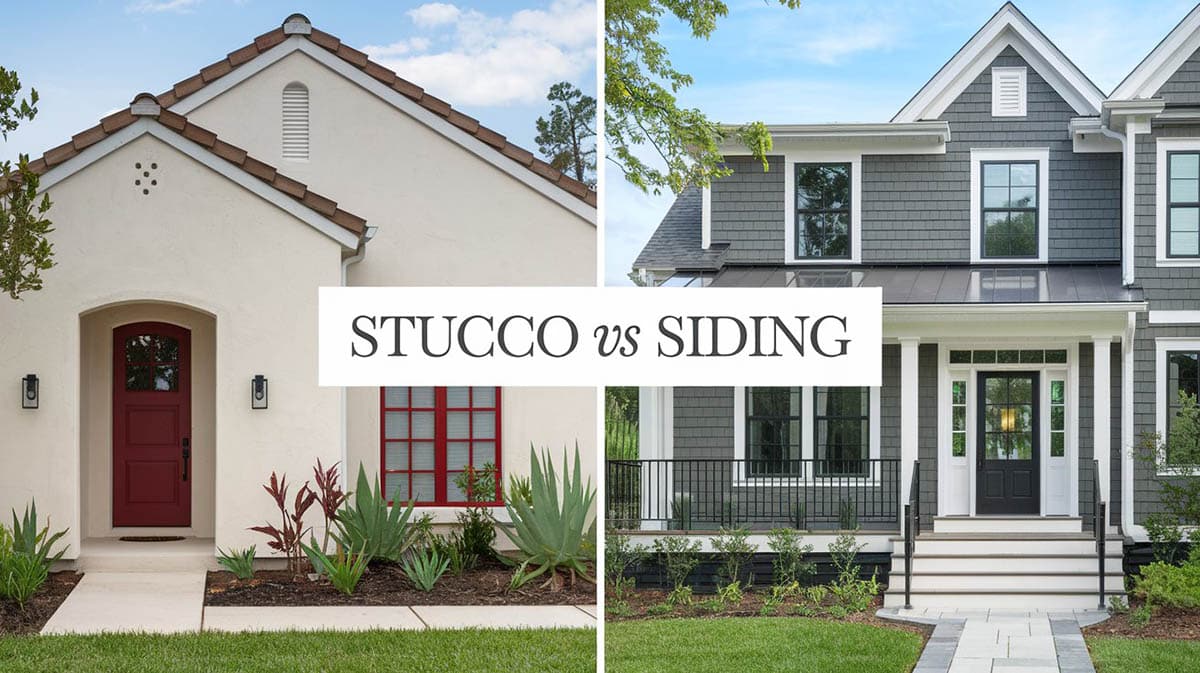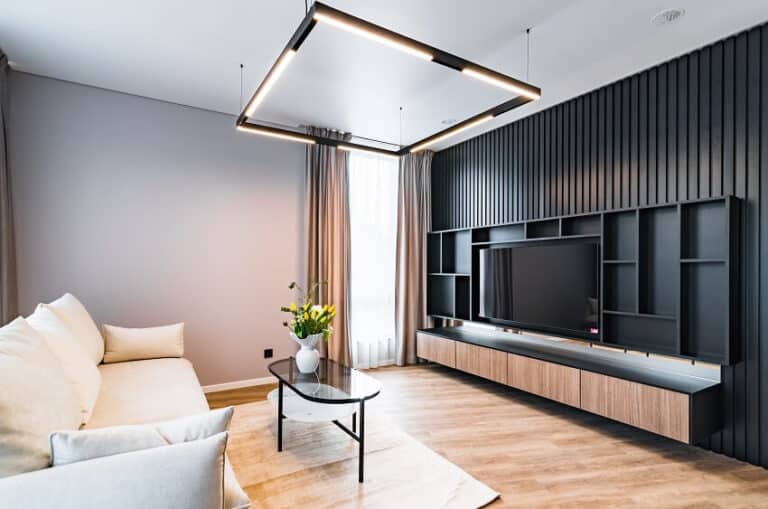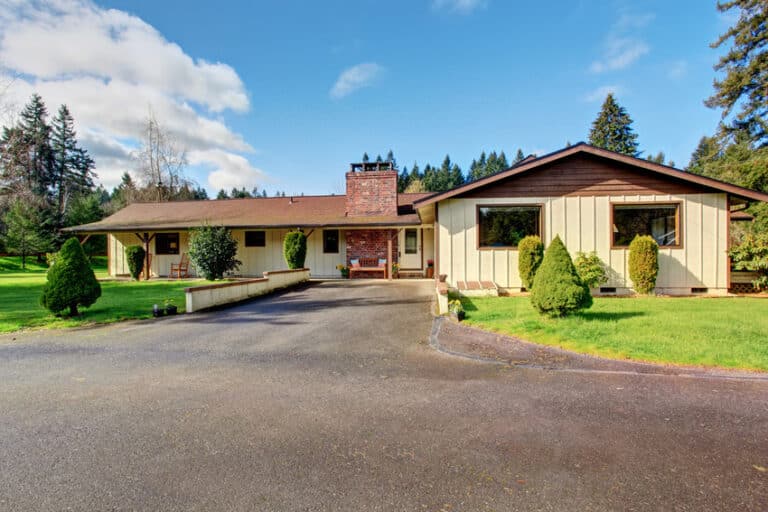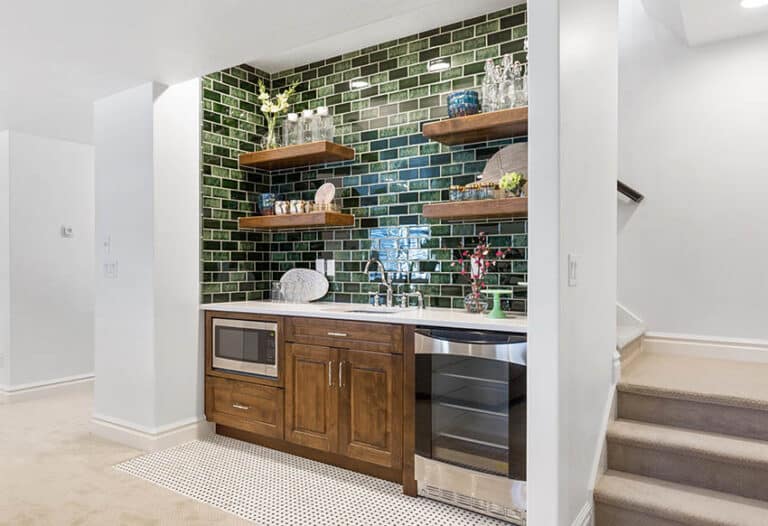Stucco vs Siding (Differences & Comparison Guide)

Stucco and Vinyl siding are two of the most commonly used options for the exterior of a home. These two types are vastly different in makeup, but both are great to use. Some descriptions of each and comparisons of the products are listed below to help you choose which option is best for your home!
What is Stucco & Vinyl Siding
Stucco – Stucco is a material used on the outside of homes that is made from a mixture of Portland cement, sand, lime and water. While it may sound like a special ingredient, Portland cement is just your standard use cement, it has just gained the nickname of cement by dropping the first word over time.
The mixture is then applied over a lath base, usually in about three coats, for optimal durability. The lath base is just a structural layer made of wood, gypsum board, or insulated board.
Stucco is a durable material that offers a resistance to fire, as well as it is quite durable and pretty low maintenance. Stucco is a great insulator for a home as well, helping keep the inside of the home at a consistent temperature throughout all seasons. This is why the style was popular in extremely warm climates as it kept the cooler air in without having to crank up the air conditioning.
Vinyl Siding – Vinyl Siding is a plastic material that is used on the outside of a lot of homes to protect from the elements. This product is made from polyvinyl chloride (PVC) Resin. This can also just be used for decoration. Vinyl siding can give a great deal of decorative or even just basic appearances.
The color, size and shape options are almost unlimited. You can select from standard vinyl siding, to siding that looks like wood clapboard, board and batten, or even shakes. Vinyl siding can replace the need for using aluminum or fiber cement as a siding, since vinyl siding is so versatile.
Vinyl siding is easy to maintain and does not need to be regularly painted. Vinyl siding is also a very affordable product to use as siding.
Cost of Stucco vs Siding
Stucco: The average cost of materials to cover a house with stucco is about $7 to $9 per square foot. This does not include installation, which can run anywhere from $8000 to $12000 for an average-sized home.
On top of that, if an existing home needs to be re-stuccoed, there should be an additional estimate of $1 per square foot to remove the original stucco from the home. This can vary from location to location and from each contractor, company, or store.
Vinyl Siding: Vinyl siding is an extremely affordable product running only about $1 to $8 per square foot, depending on how fancy of materials you decide to purchase.
Additionally, the price to install vinyl siding is about $2500 to $10000 for the average home, again depending on the trickiness of the design and size of the home. Location and conditions can also vary from location to location so be sure to check locally.
Which is More Durable Stucco vs Siding
Stucco: One downside to a stucco house is that is not super durable in certain weather conditions, like hail or winds. Even with too much precipitation, the stucco has trouble keeping some of the water out of the home. This type of construction is better and more commonly used in warm climates for this reason.
Vinyl Siding: Vinyl siding has the color completely through the product, so there is no repainting, and there isn’t much visible damage when something scrapes up against it. That being said, the overall durability has to do with the quality of installation.
This product expands with the temperature so it is not full sealed to account for that. If the product is hung too loose than the panels can be ripped off. The product can also crack or break if something extremely hard hits them. Other than that, vinyl siding can withstand most weather conditions.
Winner: Vinyl Siding
For an even more durable material, one could consider a house with a brick exterior.
Which is Easier to Maintain, Stucco or Siding?
Stucco: Stucco’s color will fade over time; therefore, it will need to be painted periodically. But that just gives a chance to change the color when you feel the need to spice things up!
Vinyl Siding: Thankfully, the color of vinyl siding is consistent throughout, so no repainting is necessary! All it needs is a rinse off, maybe once a year, and it will look fresh. Unfortunately, water can get in between these panels and create mold or mildew.
Winner – Vinyl Siding!
Which is the Most Energy Efficient Choice, Stucco or Siding?
Stucco: Stucco is one of the best choices for energy efficiency. Stucco keeps the inside climate super consistent and is used in the hotter regions because of this quality. There are no holes or crevices, and the product is thick, which prevents anything from entering or leaving the home.
Vinyl Siding: Vinyl siding does not provide much protection in terms of insulation. Additional insulation has to be added to the home to provide any energy efficiency to spaces. When it comes to energy efficiency for stucco vs. siding, stucco wins.
Winner – Stucco
Which Has The Best ROI (Return On Investment)
Stucco: The return on investment for stucco will greatly differ depending on where it is installed. Keep in mind that stucco is a pretty expensive type of exterior finish, so getting the full return will be trickier than with some cheaper options. Typically, the return on investment is about 70%.
Vinyl Siding: Vinyl siding is becoming a more accepted material to use on homes, so it is not a hindrance to the return investment of a home. Vinyl siding can be used very creatively to make a less-than-desirable home look beautiful for a relatively lower cost. This can both help and hurt. It may look good, but will people think you are covering something up?
For historically significant homes, replacing the vinyl siding will greatly increase the return investment since it will not be outrageous in price and the interested buyer will see that it is new but still playing off the original design intents. Typically the return on investment is about 80%. You can compare prices of different types of siding to help you decide if budget is the most important.
Winner: Vinyl Siding
For more related ideas, visit our guide to exterior house colors.







It’s really good to know that vinyl siding can keep the color on a house for a long time and require little maintenance at all. Painting has never been my forte and doing this for a house is even more difficult for me since I know that you can get a lot of things wrong when doing it and run into a lot of complications down the line. With that said, I’ll look for a vinyl siding installation contractor instead and have them install some siding in the color I want.